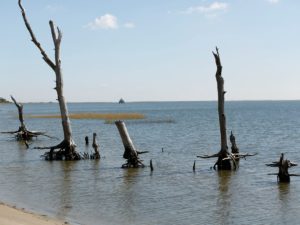Relevance: Prelims/Mains: G.S paper III: Environment

Context
Huge swaths of contiguous forest are dying. They’re now known in the scientific community as ‘ghost forests’
Why in news?
Permanent flooding has become commonplace on this low-lying peninsula, nestled behind North Carolina’s Outer Banks. The trees growing in the water are small and stunted. Many are dead.
Throughout coastal North Carolina, evidence of forest die-off is everywhere. Nearly every roadside ditch I pass while driving around the region is lined with dead or dying trees.
The study
- As an ecologist studying wetland response to sea level rise, I know this flooding is evidence that climate change is altering landscapes along the Atlantic coast.
- It’s emblematic of environmental changes that also threaten wildlife, ecosystems, and local farms and forestry businesses.
- Like all living organisms, trees die. But what is happening here is not normal. Large patches of trees are dying simultaneously, and saplings aren’t growing to take their place.
- And it’s not just a local issue: Seawater is raising salt levels in coastal woodlands along the entire Atlantic Coastal Plain, from Maine to Florida.
- Huge swaths of contiguous forest are dying. They’re now known in the scientific community as “ghost forests.”
The insidious role of salt
- Sea level rise driven by climate change is making wetlands wetter in many parts of the world. It’s also making them saltier.
- Every couple of months, I suit up in heavy rubber waders and a mesh shirt for protection from biting insects, and haul over 100 pounds of salt and other equipment out along the flooded trail to my research site.
- After two years of effort, the salt didn’t seem to be affecting the plants or soil processes that we were monitoring.
- Rising seas are inundating North Carolina’s coast, and saltwater is seeping into wetland soils. Salts move through groundwater during phases when freshwater is depleted, such as during droughts.
- Saltwater also moves through canals and ditches, penetrating inland with help from wind and high tides.
- Dead trees with pale trunks, devoid of leaves and limbs, are a telltale sign of high salt levels in the soil. A 2019 report called them wooden tombstones.
As the trees die, more salt-tolerant shrubs and grasses move in to take their place.
The state’s coastal region has suffered a rapid and widespread loss of forest, with cascading impacts on wildlife, including the endangered red wolf and red-cockaded woodpecker. Wetland forests sequester and store large quantities of carbon, so forest die-offs also contribute to further climate change.

